
The Battle of Iwo Jima was a major battle in which the United States Marine Corps (USMC) and United States Navy (USN) landed on and eventually captured the island of Iwo Jima from the Imperial Japanese Army (IJA) during World War II. The American invasion, designated Operation Detachment, had the purpose of capturing the island with its two airfields: South Field and Central Field.

Sands of Iwo Jima is a 1949 war film starring John Wayne that follows a group of United States Marines from training to the Battle of Iwo Jima during World War II. The film, which also features John Agar, Adele Mara and Forrest Tucker, was written by Harry Brown and James Edward Grant, and directed by Allan Dwan. The picture was a Republic Pictures production.
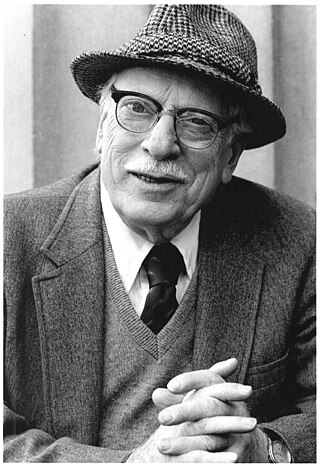
Joseph John Rosenthal was an American photographer who received the Pulitzer Prize for his iconic World War II photograph Raising the Flag on Iwo Jima, taken during the 1945 Battle of Iwo Jima. His picture became one of the best-known photographs of the war, and was replicated as the United States Marine Corps War Memorial in Arlington, Virginia.
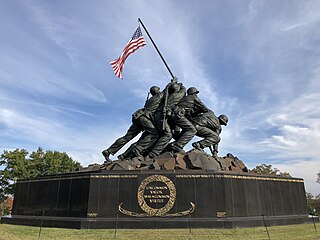
The United States Marine Corps War Memorial is a national memorial located in Arlington County, Virginia. The memorial was dedicated in 1954 to all Marines who have given their lives in defense of the United States since 1775. It is located in Arlington Ridge Park within the George Washington Memorial Parkway, near the Ord-Weitzel Gate to Arlington National Cemetery and the Netherlands Carillon. The memorial was turned over to the National Park Service in 1955.
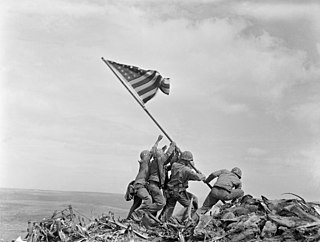
Raising the Flag on Iwo Jima is an iconic photograph of six United States Marines raising the U.S. flag atop Mount Suribachi during the Battle of Iwo Jima in the final stages of the Pacific War. The photograph, taken by Joe Rosenthal of the Associated Press on February 23, 1945, was first published in Sunday newspapers two days later and reprinted in thousands of publications. It won the Pulitzer Prize for Photography and was later used for the construction of the Marine Corps War Memorial in 1954, which was dedicated to honor all Marines who died in service since 1775. The memorial, sculpted by Felix de Weldon, is located in Arlington Ridge Park, near the Ord-Weitzel Gate to Arlington National Cemetery and the Netherlands Carillon. The photograph has come to be regarded in the United States as one of the most significant and recognizable images of World War II.

Mount Suribachi is a 169-metre (554 ft)-high mountain on the southwest end of Iwo Jima in the northwest Pacific Ocean under the administration of Ogasawara Subprefecture, Tokyo Metropolis, Japan.

René Arthur Gagnon was a United States Marine Corps corporal who participated in the Battle of Iwo Jima during World War II.

Michael Strank was a United States Marine Corps sergeant who was killed in action during the Battle of Iwo Jima in World War II. He was one of the Marines who raised the second U.S. flag on Mount Suribachi on February 23, 1945, as shown in the iconic photograph Raising the Flag on Iwo Jima by photographer Joe Rosenthal. Of the six Marines depicted in the photo, Strank was the only one to be correctly identified from the beginning; the other five were either assigned the wrong locations, or, were given the names of Marines who were not in the photo.

Franklin Runyon Sousley was a United States Marine who was killed in action during the Battle of Iwo Jima in World War II. He was one of the six marines who raised the second of two U.S. flags on top of Mount Suribachi on February 23, 1945, as shown in the iconic photograph Raising the Flag on Iwo Jima.

Flags of Our Fathers is a 2006 American war drama film directed, co-produced, and scored by Clint Eastwood and written by William Broyles Jr. and Paul Haggis. It is based on the 2000 book of the same name written by James Bradley and Ron Powers about the 1945 Battle of Iwo Jima, the five Marines and one Navy corpsman who were involved in raising the flag on Iwo Jima, and the after effects of that event on their lives.

The Last Bomb was a 1945 propaganda film mainly concerning the conventional phase of the bombing of Japan in 1945. It was nominated for an Academy Award for Best Documentary Feature.
Louis R. Lowery was a United States Marine Corps captain. He was the only Marine Corps combat photographer to cover six major campaigns during World War II. He is best known for taking the first photographs of the first American flag that was raised on top of Mount Suribachi during the Battle of Iwo Jima on the morning of February 23, 1945.

The 2nd Battalion, 28th Marine Regiment is an infantry battalion of the United States Marine Corps. The battalion which is part of the 28th Marine Regiment, 5th Marine Division, fought in the Battle of Iwo Jima during World War II. Six Marines of E Company, 2nd Battalion, 28th Marines were featured in the historical photo by Joe Rosenthal of the U.S. flag raising on top of Mount Suribachi.

Ernest Ivy "Boots" Thomas Jr. was a United States Marine Corps platoon sergeant who was killed in action during the Battle of Iwo Jima in World War II. He was awarded the Navy Cross for extraordinary heroism while fighting for and at the base of Mount Suribachi. Two days later he was a member of the patrol that captured the top of Mount Suribachi where he helped raise the first U.S. flag on Iwo Jima on February 23, 1945. He was killed eight days after that.
Harold George Schrier was a United States Marine Corps lieutenant colonel who served in World War II and the Korean War. In World War II, he was awarded the Navy Cross for leading the patrol that captured the top of Mount Suribachi, where he helped raise the first U.S. flag on Iwo Jima on February 23, 1945. In the Korean War, he was wounded in North Korea during the Battle of Chosin Reservoir while commanding a rifle company.
Charles W. Lindberg was a United States Marine Corps corporal who fought in three island campaigns during World War II. During the Battle of Iwo Jima, he was a member of the patrol which captured the top of Mount Suribachi where he helped raise the first U.S. flag on the island on February 23, 1945. Six days later, he was wounded in action.

Letters from Iwo Jima is a 2006 Japanese-language American war film directed and co-produced by Clint Eastwood, starring Ken Watanabe and Kazunari Ninomiya. The film portrays the Battle of Iwo Jima from the perspective of the Japanese soldiers and is a companion piece to Eastwood's Flags of Our Fathers, which depicts the same battle from the American viewpoint; the two films were shot back to back. Letters from Iwo Jima is almost entirely in Japanese, despite being co-produced by American companies DreamWorks Pictures, Malpaso Productions and Amblin Entertainment.
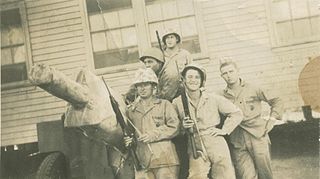
Glamour Gal is a 1945 propaganda film documentary film about the eponymous large artillery gun and the ten Marines who work her, "a team of eleven".
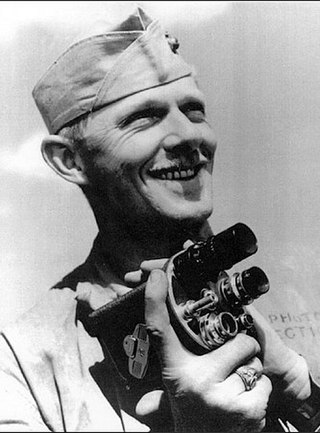
William Homer Genaust was a United States Marine Corps sergeant who was missing in action during the battle of Iwo Jima while serving as a war photographer in World War II. He is best known for filming the second U.S. flag-raising on top of Mount Suribachi on February 23, 1945, which was immortalized in Joe Rosenthal's famous photograph Raising the Flag on Iwo Jima. Genaust operated a then-modern and lightweight 16 millimeter motion picture camera which used 50-foot color film cassettes. His motion picture of the flag-raising became one of the best-known film clips of the war, and documents the event famously depicted in the Marine Corps War Memorial in Arlington, Virginia. Genaust was reportedly killed in action nine days later, and his remains have not been recovered.
















